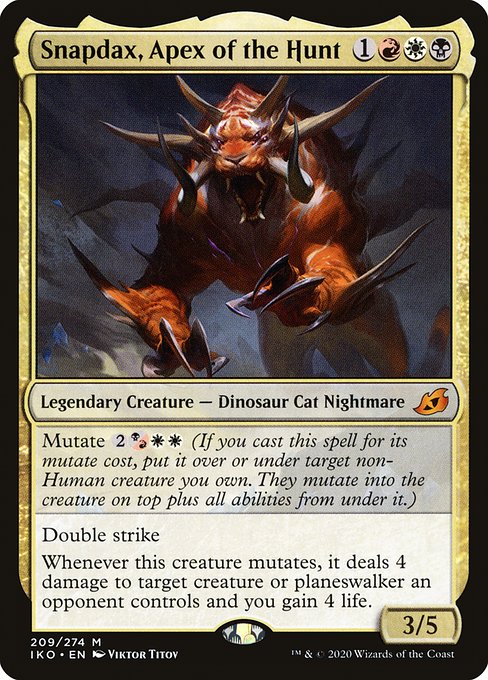
Image courtesy of Scryfall.com
Engagement Across Archetypes: A Mutating Case Study
Magic: The Gathering has always rewarded players who can think across archetypes, and Ikoria’s mutate design—embodied by a legendary Dinosaur Cat Nightmare with three-color identity—stands as a prime example. This card invites players to experiment with aggro, midrange, and control shells by swapping roles mid-game, all while keeping the table on its toes. 🧙♂️🔥💎 In a format where tempo battles, life totals, and removal wars collide, the mutate mechanic becomes a social and strategic catalyst, pushing everyone to adapt and engage at every stage of the game. ⚔️
Mutate as a bridge between archetypes
The core gimmick—mutate cost that can layer this creature over or under another non-Human you own—turns every play into a mini-archetype decision tree. When you pay the mutate cost, you’re not simply stacking stats; you’re re-sculpting the battlefield. The card text promises: you mutate into the creature on top plus all abilities from under it, effectively enabling a chameleon-like evolution mid-fight. This is where engagement spikes: opponents must reassess traps, blockers, and planewalker targets, because a single mutate event can swing a race in your favor and force a coordinated removal answer. 🧙♂️🎲
- Aggro-oriented players: mutate onto a lean threat to surprise with double strike and a sudden life swing, pressuring opponents' life totals while your open mana remains a threat for further mutates.
- Midrange builders: leverage the 3/5 body with triple-color identity to anchor your curve while mutating into a behemoth that doubles as removal insurance through its battle-cracking trigger.
- Control crews: use mutate to present a high-impact vise that demands answers, turning fetchlands and counterspells into opportunities to drive opponents toward exhaustion.
- Commander enthusiasts: the tri-color identity and mutate layering make this a flexible commander option in multi-color decks, inviting diverse color pools and multi-faceted add-ons from the Ikoria block’s mutate ecosystem.
Gameplay dynamics across formats
In formats where this card is legal—Historic, Modern, Legacy, and especially Commander—the mutation creates an ever-shifting threat. Its base card—a 4-mana, 3/5 with Double strike—is already a credible beater, but the real juice comes when it mutates. Each mutate event triggers 4 damage to a target creature or planeswalker an opponent controls and life gain of 4. That
is not merely damage; it’s tempo, attrition, and survivability wrapped into one. In multiplayer formats, that lifegain can become a comeback mechanic, letting you weather a board wipe or aggressive onslaught and rebuild under a different banner. In one breath, it’s a frontline enforcer; in the next, it’s a volatile snowball that keeps opponents scrambling for answers. ⚔️💎
Flavor, lore, and design ethos
Ikoria: Lair of Behemoths built a world where wildlife is augmented by magic—the mutate mechanic embodies that idea: a creature morphs into something larger, stranger, and more capable. The flavor text and art by Viktor Titov evoke a predator’s instinct, a hunter that blurs the lines between cat, dinosaur, and nightmare. The design fits the set’s aim to empower experimentation and cross-pollination of strategies, reminding players that magic is about adaptation as much as it is about raw power. The result is a card that doesn’t just sit on a table; it reshapes how players approach each turn. 🎨🧪
Mutate isn’t just a rule; it’s a philosophy—cards grow with you, and your options grow with the table.
Art, value, and collector’s perspective
The card’s mythic rarity spots it as a centerpiece for collectors and midrange enthusiasts alike. In the wild, foil editions add a shimmering edge to the mutate aesthetic, which makes it a popular pick for display-worthy decks and conversation pieces. Collectors often track Ikoria’s mutate lineage not only for raw power but for the way these cards tell a story about a world being reshaped by its own appetite for behemoths. Current market figures show modest prices for non-foil variants and a touch more for foil copies, underscoring the card’s enduring appeal among players who appreciate both function and flavor. 🔥💎
Design takeaways for players and builders
For deck builders, the key lesson is that engagement thrives where transition points exist—mutate provides a built-in pivot. When you draft or assemble a tri-color mutate shell, you’re inviting opponents to respond to layered threats, while you maintain flexibility to pivot mid-game. That dynamic keeps games lively, interactive, and full of “aha” moments—precisely the kind of tabletop theatre fans crave.
Where this fits in the collectible ecosystem
As Ikoria’s mutate ecosystem matured, players discovered how to leverage cross-archetype synergies—how a single mutate can turn a standstill into an opening to launch a new plan. The card’s identity—Dinosaur Cat Nightmare—also lends a playful, chaotic flavor to table talk, hinting at the kind of unpredictable moments that make MTG nights memorable. And while the table debates whether to remove the threat now or hold onto it for a bigger swing later, the mutating threat keeps everyone engaged, trading decisions back and forth like a well-tuned dueling engine. 🎲
For fans who want to keep the magic glowing at their desk between sessions, a slick, reliable mouse pad can be the unsung hero of a smooth gaming night. If you’re after a tasteful upgrade for your setup, consider the Neon Gaming Non-Slip Mouse Pad—a small edge that helps you stay focused on the table as life totals climb and minions collide. 🧙♂️⚔️